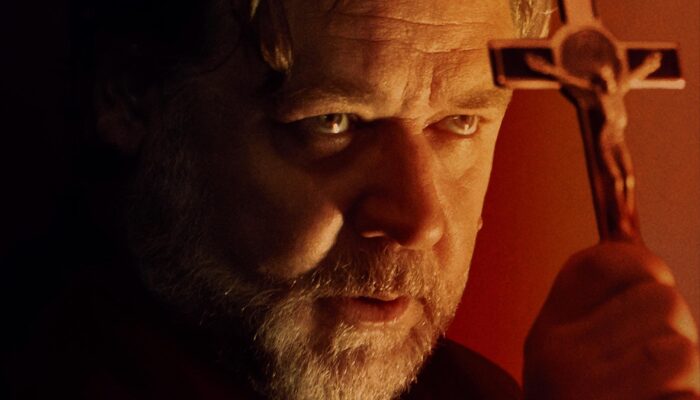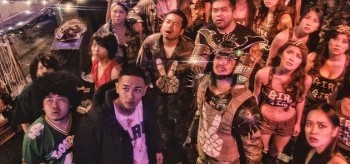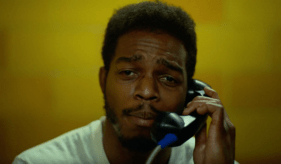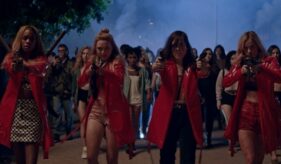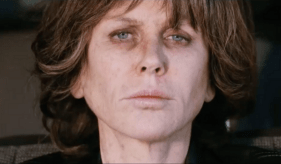Film Review: TOKYO TRIBE: Hardcore Hip-Hop Kabuki, If You Dare [LFF 2014]
Tokyo Tribe (2014) Film Review from the 58th Annual BFI London Film Festival, a movie directed by Shion Sono, starring Hitomi Katayama, Akihiro Kitamura, Tomoko Karina, Ryôhei Suzuki, Young Dais, Riki Takeuchi, Nana Seino, Yôsuke Kubozuka, and Shota Sometani.
Tokyo Tribe went a long way, through some very vile & violent paths, to convey a simple message of tolerance & unity; but it was the how, of Shion Sono & Santa Inoue’s dance-hall dystopia, that made the film what it was. First came the rhythm, then came the beat, enter the MC, and the story told itself. Sort of.
MC Show (Shota Sometani) introduced a post-cataclysm Tokyo, where generations of street toughs have filled in the void left in the disaster’s wake. What they filled it with was the stuff of youth culture left unsupervised for way too long. So long, in fact, that what passes for the authorities knows better than to interfere with the new Hip-Hop order of things. I suppose you know you’re watching a music video when lady cops are wearing mini-skirts & heels (while meaning business, anyway); but it was left to one unfortunately earnest female officer to facilitate the film’s setup.
The setup profiled the various tribes that have carved out tightly controlled districts of Tokyo for themselves. As spun by Mera (Ryôhei Suzuki), leader of the Bukuro Wu-Ronz, each tribe introduced itself with lyrics & stylings meant to self-glorify, by way of intimidation. All but one, that is. The Musashino Saru were singled out, by Mera, as a problem – but not the kind he was worried over, mind you. No, Mera just had a particular contempt for Musashino; and their own introduction underscored why.
The difference in style, between Musashino Saru & the other tribes, was as stark as Breakin’ was from Boyz n the Hood.
The story actually began with the crowning of new Shinjuku Hands Boss, Iwao (Shunsuke Daitô); tasked with rubbing out the competition. That is, if chief rival Shibuya Saru lets them. Or the Nerimuthafuckaz, for that matter. Or Koenji Jack? – there were 23 tribes, in all, that likely wanted a say in the matter, okay? The real problem, however, is that it didn’t matter. A much more powerful force was waiting in the wings to eradicate all the tribes.
Even as Iwao suited up for the role of Shogun, naive party girls were being lured into sex slavery, off the street. One in particular, Sunmi (Nana Seino), wasn’t so much lured as abducted (she was passed out when the ‘shuttle van’ made the collection stop), and the young boy that sat next to her managed to slip on-board, as well. Despite his warning, that Sunmi was ‘screwed,’ the pair of them would amount to a surprising amount of trouble for their captors. Unfortunately, Sunmi would also play a key role in Mera’s schemes.
Mera distinguished himself early, from the other bosses, by sexually humiliating the reckless lady cop, before a crowd, exercising some admittedly impressive control of a blade. He did, however, have to defer to Lord Buppa (Riki Takeuchi), ruler of Buppa Town, and father to Nkoi (Yôsuke Kubozuka), collector of Human furniture. If Mera was a vile thug, then Buppa was a sadist with insatiable (and terrifyingly morbid) appetites. He also looked like Big Boy Caprice crossed with an Arrancar (Tokyo Tribe being adapted from a manga, after all), which didn’t help his image, any. Mera would be considered a Japanese Dolph Lundgren; if I could actually see Dolph pulling off the role – which I don’t. Not even on the best day of hs career (which was Johnny Nmemonic, IIRC).
Mera wanted to take his beef with Musashino Saru to war, but Buppa didn’t have enough regard for Musashino to condone it. With Nkoi’s interest in Mera’s desired vendetta, however, a simpler scheme was hatched. As it hinged on Sunmi, she needed to be subjugated. Easier said than done, as no one short of Mera was up to the task, and her young companion proved to be very hard to be rid of.
With the renown talents of the brothels under Buppa’s control as bait (new attraction Sunmi, in particular), a member of Musashino was lured to Bukuro. This prompted a retrieval effort by Kai (Young Dais), a singular target of Mera. You see, Mera, like any self-styled thug understood & respected strength (what he regarded as representative of that strength… well, that came later). Kai was certainly strong enough; but his unwillingness to use that strength made both him, and his Tribe appear to be weak. Worse than that, it made them out to look like posers & hypocrites. Well, according to Mera’s beef, anyway. Honor (such as it was) demanded an example be made of the likes of Kai.
It seems morbid curiosity was the full extent of Nkoi’s interest (that, or a blow from Sunmi took the novelty out of the situation). Once the killing started, he seemed perfectly content with letting the kid take off with Sunmi. Mera’s trap dealt Kai’s party a serious blow; but even as he led Kai on a merry chase (literally, he was all LMAO the whole time), Buppa was receiving a pair of ‘specialists,’ tasked with retrieving the daughter of the High Priest – the one person Lord Buppa bows to.
At this point, Buppa decided to sweep all of Tokyo clear of rival Tribes, unleashing his secret army of Waru. Uniformedly dressed in black hoodies, they were a vision of a ceaseless horde; reminiscent of 300‘s Immortals – but with better rhymes. They seemed unstoppable, but ultimately served as the plot device that brought the various threads together. The threat of the Waru, and one victim of Mera’s ambush becoming a martyred rallying point for multiple Tribes.
Between the arrival of the Waru, the revelation of the High Priest’s daughter, and his two agents finding her trail, however, the violence sort of lost all symmetry; but the realignment held. The Waru were to serve Mera’s ambitions, which in turn, were to serve Lord Buppa’s grand scheme, involving the High Priest. The High Priest’s daughter, however, had her own agenda, which just happened to align with Kai’s crew. This was essentially the central plot that facilitated the rise of the one Tokyo Tribe.
What’s left, then, was the execution. There was no shortage of choreography skill, on display, and the sometimes jarring inconsistencies, from one tribesman’s turn at mic to another, shouldn’t be too much trouble for those with an ear for the style. Never mind the Engrish, Hip-Hop remains an acquired taste. Once you have that taste, it becomes more about the ability to convey a message, and portray an image – both qualities the Tribes pull off. The larger question was whether Tokyo Tribe was a story worth telling, in this manner. That would be like asking if any given song needed to be sung.
Tokyo Tribe was only as poignant or pointless as you may view the world it represented, which was the so-called Hip-Hop Nation. When you combine the excess of American Hip-Hop culture, with the exaggerations of Japanese manga/ anime, don’t expect complete coherence – you’ll have more fun that way. It wouldn’t be a Hip-Hop themed street gang epic without heavy moments of vice, death, and disturbing levels of dehumanizing sex & violence; but if you can make it past these elements, in the body of the film, then you just might get a kick out of the sheer absurdity that was the climax.
The final rumble would be comparable to Enter the Dragon, had anime culture been around to influence that classic, and CGI to indulge it. Some absurd highlights ranged from classic Samurai memes (katana in booby trapped, indoor bamboo grove), to perverse (Nkoi’s living furniture becoming living weapons), to strangely appropriate (a tricked out M60 tank, and a gatling gun tucked away in a sofa), to a tribute, or two (don’t go confusing Bruce Lee‘s signature outfit with the Kill Bill jumpsuit).
Mera’s final challenge, to all present, turned out to be useful to the film’s resolution, or some pretty hard feelings would have otherwise made it much less tidy than it was. Besides, there’s nothing like an all out war to show just how petty the concept of the beef really is. That would be the point of the film, if I had to pick one.
Ryôhei Suzuki is massive, by Japanese standards (hence, Dolph), but he also brought loads of venomous charisma to his part. Not all that terrible a lyricist, either. For someone with an almost irrational hatred, Mera was consistent in acting upon it. He even picked a fight with one of the High Priest’s boss fighters – mid rumble, over the ‘suitable representation of manhood.’ Even when he seemed to go completely unhinged, it still served his disturbingly simply motivating principle. Ultimately, Mera was meant to prove that you can keep it simple, stupid, while simultaneously either going big, or going home in a box.
At first glance, I’d say the character of Nkoi was modeled after Snoop (insert quadruped title, here). He played by his own rules, on his own schedule, and, at times, didn’t play at all. Oddly enough, it was Nkoi who did the most damage, come rumble time; but only so long as his sense of motivation was kept up. He’d be a wasted character, had he not served to demonstrate the perils of sloth, borne of self-entitled over-indulgence.
The Sunmi character was a pleasant surprise, in terms of her ferociously defiant attitude – triggered at a point where she was meant to be dominated; but beyond that, she amounted to little more than an upskirt high-kicking combat asset. There was a much larger place for her, in the film’s overall story; but it was never expanded upon. I still have no idea what the kid’s story was.
Kai served as the flip side to Mera’s representation of hip-hop. Unfortunately, his late entry, and the fact that House Music is easily drowned out by Bling/ Gangsta Rap, meant that the character was doomed to be overshadowed by Mera, pretty much throughout. Making matters worse: that dynamic gave Ryôhei Suzuki more to work with than Young Dais. In the match up of styles, a venue like Tokyo Tribe favors the meaner chest thumper.
In the end, All threads & characters were in service of the film’s overall ying-yang theme. The opposite natures of Hip-Hop – street smarts & a good time, vs power & respect taken -overcome for the sake of the singular identity of a Hip-Hop nation. In that respect, no one character was meant to be anything more than a series of contributing verses. – non contributors might as well have been background dancers, seen only in silhouette. Even if Mera did have the loudest voice, this was a collaboration piece. Beats & lyrics came first; everything else just made up for the music video.
Oh, wait. I didn’t mention that most of the dialogue, and all of the plot/ setting details, were relayed to viewers through Rap/ Hip-Hop song numbers? Silly me. You may actually have to see it, now – just to experience what goes into a Japanese Rap opera. Personally, I thought the film’s absurdist elements made it fun, but its excesses brought it down. Too fun to be hardcore, too hardcore to be truly fun. It was an experience befitting of a cinematic curiosity; but my curiosity has not been fully sated. I always wanted to see something of a modern Shakespearean tale, set & told in the stylings of the ‘hood. Tokyo Tribe left me wondering what someone like John Singleton could do with the concept. Thanks for the ride, but I think I’ll wait for another to come along.
I think it was the Wu-Tang Clan that put it best: “Konichiwa, bitches.”
5/10
Related Articles
FilmBook's Newsletter
Subscribe to FilmBook’s Daily Newsletter for the latest news!




